 |
| January 14, 2014 | Volume 10 Issue 02 |
Designfax weekly eMagazine
Archives
Partners
Manufacturing Center
Product Spotlight
Modern Applications News
Metalworking Ideas For
Today's Job Shops
Tooling and Production
Strategies for large
metalworking plants
Wheels:
Maxi scooters -- Riding into new territories
BMW Motorrad is renowned for its touring bikes and, more recently, its sports bikes too. Yet with the new C600 Sport and C650 GT maxi scooters, with a powertrain engineered by Ricardo, the Munich-based premium motorcycle maker is entering a completely new sector of the market. Jesse Crosse talks to Ricardo's Paul Etheridge about how this ambitious programme was completed -- in record time.
Editor's note: Jesse Crosse is a freelance writer in Oxfordshire, UK.
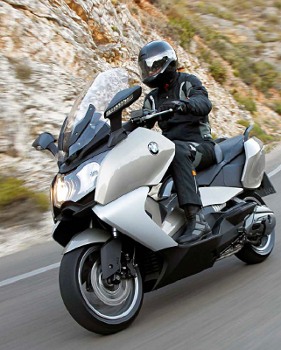
Personal private mobility is a phrase which began to appear frequently in the late 1990s: it neatly sums up the value that human beings place on independence, regardless of which socio-economic group they belong to. Urban mobility, in its turn, has now become a clearly identified sector in the motorcycle business at a time when individual use of cars in many urban areas is being discouraged or is becoming more difficult due to congestion.
Providing competitive options for two-wheeled personal mobility is thus becoming an ever more important area of the market for motorcycle manufacturers, with the need for affordable transport growing at a rapidly accelerating rate.
For premium motorcycle manufacturer BMW Motorrad this presents both an opportunity and a challenge. In the last few years the German company has been especially successful in the touring bike market and produces a number of 'best in class' products based on its iconic boxer twin engine.
BMW has also looked to expand by moving into new sectors. By launching the S1000RR in 2009 it successfully went head-to-head with established Japanese sports bike manufacturers in a highly specialized market sector. In 2011 the six-cylinder K1600, a range-topping touring bike, further established BMW in a sector which it already dominated.
Premium product -- at a cost-competitive price
For BMW this further new sector -- urban mobility, which includes scooters -- required yet another new approach to product development. The new 'maxi' scooter is available in both C600 Sport and C650 GT models, though both share the same engine capacity of 650 cm3. The new scooter does not compete with the multitude of smaller 125-400 cm3 machines available: in fact, BMW has chosen a level of the market currently occupied by only four or five competitors. Maxi scooters are especially popular in Europe, with Spain and Italy in particular representing the strongest markets. Despite the premium nature of the products (a maxi scooter costs in the region of 10,000 euros) the market is ferociously cost competitive -- so it was imperative that while incorporating all the brand image and quality attributes expected of a BMW, the new scooters would still be affordable.
Ricardo has already completed two other successful engine projects for BMW Motorrad: the four-cylinder K1300 upgrade between 2006 and 2008 was followed by design support of the six-cylinder K1600 power train between 2006 and 2010. In 2009 Ricardo was appointed to review an existing powertrain concept for the new scooter, an area of considerable previous Ricardo experience thanks to work on earlier scooter projects in the European and Asian markets. The task was to keep the price entry point competitive, yet also to simplify the design using certain well proven and readily available transmission components.
In reality, this set of objectives required a complete overhaul of the existing driveline concept, taking in everything from the engine through to the back wheel. The most popular transmission type used in scooters is the step-less automatic CVT. The original concept incorporated a bespoke CVT module, which Ricardo would need to replace with a commercially available alternative -- a major task.
Detailed engineering proposal
This first stage consisted of a short study, completed in just three months. During that time Ricardo also supported the development of a detailed engineering proposal for the main programme including the complete design, development and industrialization of the engine, transmission, swing-arm, final drive and exhaust system. It was a decision for BMW to outsource a significant amount of engineering support for this product, due to internal capacity limitations.
Ricardo supported the powertrain design, an external scooter specialist was involved in vehicle design support, a new engine control unit (ECU) was developed, and the BMW industrialization and quality team worked together with the nominated engine manufacturer. Clearly, BMW itself was the most important member of the project team, closely managing the whole process to ensure that the finished result stayed true to its original product brief and also met the exacting brand, technical, quality and cost requirements of the company.
The project was challenging for a number of reasons, the first being the challenging time schedule for the introduction of a new market sector product. Secondly, despite the relatively high cost of scooters at this level, the final product still had to remain price-competitive within the segment. In practical terms there were also geographical and cultural differences to overcome as the project was split between Germany, UK, Czech Republic, Italy and Asia. The engineers were also up against tough competition technically from two very distinct and established competitors in this sector -- for example the Yamaha TMax in the sport segment and the Suzuki Burgman in the comfort sector.
Complete powertrain design
Although they may look simple, scooters are complex machines and are if anything even more complex than a conventional motorcycle. Some premium machines like the BMW have ABS, there are a significant number of bodywork components and the driveline is both complicated and compact. Ricardo's final brief was to support the design of a complete powertrain compatible with BMW's worldwide sourcing strategy, incorporating locally sourced materials whilst employing techniques meeting BMWs exacting manufacturing and quality standards.
"During this programme we made a large number of supplier visits with designers, manufacturing engineers and test engineers so that we were in control of the overall process, frequently reviewing manufacturing aspects with component suppliers and BMW quality specialists, and the handover of documentation," explains Paul Etheridge, Ricardo's chief engineer on the project.
The powerful 647 cc engine produces 44 kW [60 hp] and 66 Nm [48 lb ft] torque. It is a twin-cylinder, four-stroke, double overhead camshaft watercooled design. The cylinders are heavily inclined towards the front at 70 degrees, a typical feature in scooters where a low step-through platform is needed. "We shouldn't underestimate the challenge of putting such a big engine in a scooter," says Etheridge. "We worked very closely with BMW and the vehicle engineering partner in the concept definition phase to make sure the package was right -- it's very tight."
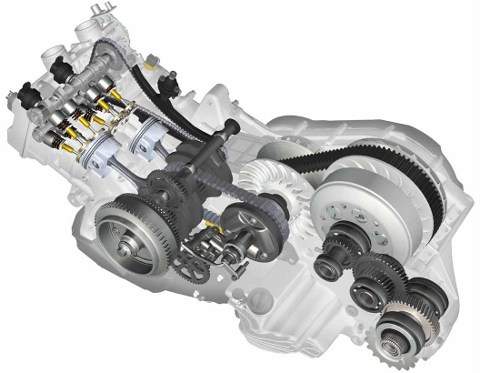
Type: 2-cylinder 4-stroke liquid-cooled engine, 4 valves per cylinder
Bore x stroke: 79 mm x 66 mm
Capacity: 647 cm3
Rated power: 44 kW at 7500 rev/min
Max. torque: 66 Nm at 6000 rev/min
Compression ratio: 11.6:1
Emission control: Closed-loop 3-way catalytic converter, exhaust standard EU-3
Maximum speed: 175 km/h
Fuel consumption at constant 90 km/h: 4.4 litres per 100 km
Fuel consumption at constant 120 km/h: 5.6 litres per 100 km
Fuel type: Premium grade fuel, unleaded 95 (RON)
Alternator: Three-phase generator, 588 W
Battery: 12 V / 12 Ah, maintenance-free
Clutch: Centrifugal
Gearbox: CVT
Final drive: Chain drive in oil bath
Crankshaft balance is a crucial aspect of the design. The engine is a parallel twin, which in itself gives a number of options in relation to crankshaft angle. "Those choices influence balance and sound as well as the manufacturing process. In this engine BMW chose a 270-degree crank," explains Etheridge. "That gives the same firing interval as you would find on a 90-degree V-twin and we settled on that crank angle for two reasons. The first was to provide better inherent vibration levels for a smoother ride. The second was to give the engine a distinctive sound, a crucial aspect of the BMW brand and something our client had specifically asked for."
Driveline
Scooters in this class usually have a double-sided swing arm for the rear suspension -- but for the BMW a single-sided swing arm was selected, also enclosing the final drive chain. Swing arm length is critical to provide good stability for the rider and in order to achieve this at the same time as locating the engine in the correct place in the chassis, the transmission is angled up at the rear to provide space for the swing arm and final drive. This arrangement of the drivetrain also provides robustness and refinement and keeps unsprung weight to a minimum for good handling.
An ideal configuration would be to mount the CVT directly on the end of the crankshaft, but the twin cylinder power unit would then be too wide. So scooter drive trains are typically arranged sequentially, one component after the other. The drive is transmitted from the crankshaft to the CVT (mounted behind the engine) by a central primary drive chain designed to last the life of the power train.
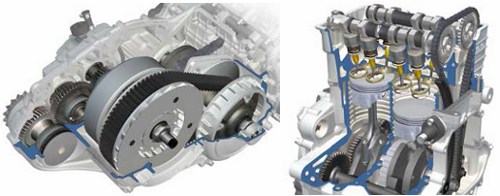
Parallel twin engine is inclined at 70 degrees forward to allow a low step-through platform, while a 270-degree crankshaft was chosen for both smoothness and a distinctive sound. Transmission is by CVT.
"It was decided to use a chain because it is efficient, quiet and presents fewer manufacturing challenges than gears," explains Etheridge. The drive sprocket on the CVT end incorporates a torsional damper to protect the chain from the peak impulses of the engine, a crucial aspect of the design.
The layout of a scooter final drive, from the output end of the CVT to the rear wheel, varies considerably from manufacturer to manufacturer. First of all there has to be a simple reduction gearbox. This cannot be placed immediately after the engine because the torque multiplication would be too high for the CVT to withstand. Beyond that is the transmission system to the rear wheel. One production solution uses no primary drive at all and has two final drive chains instead, but it could be argued that this cancels out any efficiency gained. Another solution is to use a gear train along the length of the swing arm; an elegant solution but one which, again, lacks efficiency due to the number of gears, carries an NVH risk and has a significant cost penalty compared to alternatives.
A shaft drive was ruled out on the grounds of cost, and disadvantages due to the relatively short swing arm length of the scooter, so finally BMW decided on a fully enclosed, conventional chain drive. It was further decided to run the chain in an oil bath, which is expected to last much longer than a normal chain final drive. The CVT itself needs servicing every 20,000 km, the usual interval for such a device.
Powerful sound
The original engine concept remained substantially unchanged and the 270-degree crankshaft, bore and stroke of 79 mm x 66 mm (bore size shared with BMW's K1200 motorcycle), balancer shaft layout and double overhead camshaft were all carried forward throughout the project.
However, Ricardo carried out a good deal of detailed work to make the design production ready. The usual refinement and analysis of the engine's gas flow and the mechanics of the valve train were achieved using WAVE and VALDYN respectively to optimize combustion efficiency and valve train dynamics. Then Ricardo's design team performed some detailed engineering to integrate certain BMW standard parts into the engine. A considerable amount of analysis was also done on the driveline, again using VALDYN. In addition, Ricardo worked closely with the primary chain supplier, which also performed its own independent analysis to ensure the absolute robustness of the final component.
By streamlining and basing the engine around globally produced components and BMW standard parts, Ricardo was able to improve powertrain efficiency and cut the bill of materials for the powertrain from the original concept layout without compromising quality: a major achievement.
The usual BMW development process involves building a first prototype to prove that the design can achieve the planned power and torque outputs, but on this occasion things were different, as Paul Etheridge explains: "This is one of the first BMW Motorrad products which has gone through the early project gateways based solely on analysis and simulation results. I think that is a real plus point for Ricardo's process, which involves front-loading with analysis using our extensive CAE software tools to reduce the number of design and development iterations and associated prototype costs. We had to prove that we could do that to shorten the normal new product development process."
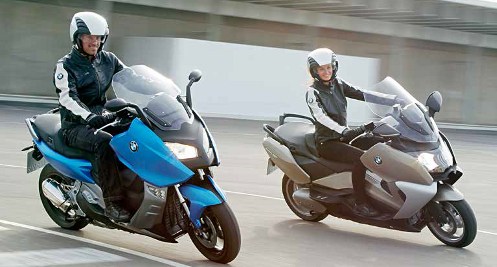
Sophisticated analysis and simulation techniques meant that there was no need to build costly prototypes to prove that the engine could deliver the planned power and torque outputs.
Positive reviews
The C600 Sport and C650 GT are now in production and receiving good reviews. "The engine and transmission work well together, not always a given with this kind of CVT drivetrain," said the UK Daily Telegraph, adding "on many scooters there's a small delay between opening the throttle and the drive being taken up, making low-speed riding awkward, but on the BMWs it's immediate, smooth and predictable, and when you give it a handful the acceleration is strong: 0-60 mph takes less than 6 seconds."
Motor Cycle News also gave the engine the thumbs up, calling it "powerful for a scooter, with a very motorbike-like throaty roar." Ridermagazine.com liked the power train, too, reporting that "the two scooters accelerate briskly and cruise at high speed ... like motorcycles."
North America's Cycle World, testing the range in Madrid, was equally enthusiastic, describing the comfort and convenience of the new model as "all very scooter-like but with a lot more punch from the engine bay ... . That's an important point: The GT (and the 2-in. shorter overall, 25-lb. lighter Sport) is not a gutless grocery-getter."
The new C600 Sport and C650 GT clearly represent another success for Ricardo and its client, BMW. It is an achievement of which both companies are rightly proud. Together with its partners, BMW has succeeded in producing a premium product at the right price and, perhaps even more importantly, delivering the kind of performance and brand attributes that its customers demand.
SIDEBAR
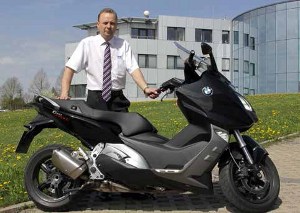 The motorcycle sector is a complex one, and understanding it requires in-depth product engineering and industry knowledge, as Paul Etheridge, recently appointed head of the Ricardo's German-based Centre of Excellence in Motorcycle Engineering explains.
The motorcycle sector is a complex one, and understanding it requires in-depth product engineering and industry knowledge, as Paul Etheridge, recently appointed head of the Ricardo's German-based Centre of Excellence in Motorcycle Engineering explains.
It's absolutely crucial to understand the market and technology context of motorcycle and other two-wheeler projects, and to empathize with the product's customers. One of the key factors that makes our Centre of Excellence so successful in serving premium, technology-led brands such as BMW (and others) as well as the more volume and value-driven manufacturers in emerging Asian markets is that our team lives and breathes the product.
We are all very keen motorcyclists, and we understand not only what influences the customer, but also the underlying technologies and the imperatives of each market. In my own case, I have been working on motorcycle projects at Ricardo for nearly 30 years -- almost as long as I have held a motorcycle licence.
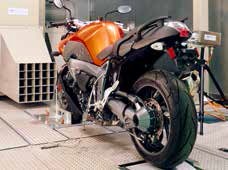
Ricardo has a unique track record of successfully delivering motorcycle engineering projects dating back to the 1920s, and in the past 25 years we have developed our motorcycle engineering activities around a specialist team equipped with dedicated facilities. In my opinion none of our competitors can provide such a proven, specialized and diverse whole motorcycle engineering service.
Working with our colleagues across the global Ricardo organization, we can deliver almost any complexity of motorcycle or personal transportation project, from the most technologically advanced products for luxury and sports brands to the most value driven for emerging markets. In addition, based at our Motorcycle Centre of Excellence we have added significant new development resources including, for example, the recent commissioning of our brand new motorcycle chassis dynamometer facility.
From concept design to production implementation, and while meeting the technology transfer and engineering needs of our global clients, our aim is always to create a fantastic product that customers will want to buy. That's where our extensive experience and enthusiasm for motorcycles really pays dividends for Ricardo clients worldwide.
This article was originally published in the Ricardo Quarterly review magazine, RQ, issue Q2 2013. Re-published with permission and gratitude from Designfax's partner, Ricardo. For further information, contact media@ricardo.com.
Published in Designfax January 2014
Rate this article
View our terms of use and privacy policy
